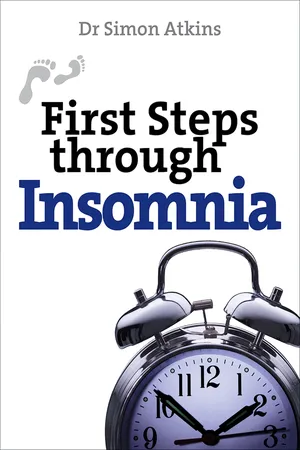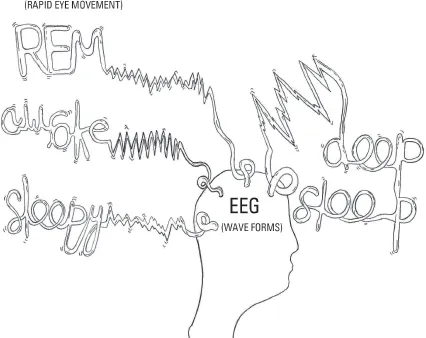![]()
1
Why we sleep
Sleep is a biological feature of the lives of all mammals on the planet. Every squirrel, manatee, tiny little shrew, and magnificent elephant will have its necessary share of shut-eye. Birds and fish go to sleep too and there’s also evidence that invertebrate species such as bees and scorpions have periods during every twenty-four hours when they are less responsive than usual and seem to have dozed off.
The amount of sleep needed varies wildly between species from the brown bat, which will spend 19.9 hours of every day out for the count, to the giraffe, which naps for just 1.9 hours out of every twenty-four.
For humans, our “normal” sleep duration changes as we get older. As babies, we spend an average of sixteen hours a day asleep (waking only at night to frustrate our parents). We will get around eight hours through most of adulthood, but only five and a half when we reach old age. And, of course, teenagers will try to avoid getting up at all when possible!
Why do we sleep?
Given that sleep seems to have evolved across an enormous range of species, there must be some sort of critical biological need for us to doze off for a few hours every night. But, despite years of research, the jury is still out about what the purpose of sleep actually is. There are, however, a number of well-established theories put forward to explain it.
Evolutionary theory
One of the earliest theories about sleep was that it served as a protective mechanism by keeping animals out of harm’s way when it was dark, when they would be more vulnerable to being killed and eaten by something with sharper teeth and claws that they didn’t see until it was too late. This is backed up by the fact that animals with few predators tend to sleep longer than those who are regularly on the menu of other creatures.
However, there’s an obvious flaw in this theory because the fact that your prey is sound asleep at night, and therefore unaware you are sneaking up on it, no doubt makes late-night dining even more attractive for predators, who will have to do very little work to earn their supper. As sleeping prey, you might as well be presented on a plate with a knife and fork laid out ready beside you.
It’s also been suggested that sleep evolved to allow for energy conservation, which makes a little more sense, but the vulnerability issue still persists.
Repair and restoration theory
This theory says that we go to sleep so that our bodies and brains can be restored and revitalized and keep functioning at an optimum, healthy level. It’s thought that, as part of this process, tissues are repaired and the brain gets rid of toxic waste products.
To use a computer analogy, it’s a bit like sleep allows us to run a disk check, virus scan, and defragmentation of our hard drives.
Information consolidation theory
Proponents of this theory have evidence to suggest that during sleep the brain consolidates information it’s taken in the day before in order to prepare for tomorrow. It also gives the brain a chance to make long-term memories more permanently hard-wired.
In conclusion
What’s clear from the fact that there are so many theories is that we don’t really know why we sleep. It’s likely that there’s some truth in all of them and that we go to sleep for a number of important reasons.
What happens if we don’t have enough sleep?
Although there is obvious argument about why we sleep, there is plenty of agreement about what happens if we don’t get enough of it. Some of the effects are serious, whereas others are more of an annoyance, affecting our ability to function normally at home or at work.
Serious consequences of lack of sleep
If you suffer from long-term sleep deprivation, you are at increased risk of a number of conditions that can be potentially life-threatening. The big five of these are listed below.
- Obesity. If you regularly have poor sleep, you are 30 per cent more likely to become obese than those who sleep well. The culprits here are thought to be two hormones that control our appetite. If you are sleep-deprived, you will have a higher level of ghrelin, which boosts appetite, and low levels of leptin, which makes us feel full after a meal.
- Diabetes. Poor sleep affects the way our bodies deal with blood sugar and increases the risk of developing diabetes. Add to this what we have just observed about the affect of insomnia on obesity, which is also a risk factor for diabetes, and the overall risk gets even higher.
- High blood pressure. Lack of sleep will raise your blood pressure to persistently high levels, and if you already have hypertension it will push it up further. The reason for this isn’t yet clear, though.
- Heart disease. A combination of higher blood pressure and raised levels of inflammatory chemicals in the bloodstream of poor sleepers makes damage to blood vessel walls more likely, and this can trigger heart disease. Chronic insomnia also causes a raised pulse level, which is another contributing factor.
- Depression and anxiety. Sleep is needed to maintain good mental health, and a long-term lack of it will put you at risk of low mood and nervousness. One research study of 10,000 people found that poor sleepers were five times more likely to suffer from depression than those who slept well.
Other consequences
- Poor fertility and sex drive. If you are tired from lack of sleep, there’s a good chance that your sex drive will be really low compared with someone who’s rested and therefore “raring to go”. Reproductive hormone cycles are also upset by insomnia and this can affect your chances of conceiving.
- Reduced immunity. Sleep helps keep your immune system ticking over and without it you are likely to pick up every cough and cold that’s going around.
- Greater risk of having accidents. When you’re sleepy in the daytime, concentration is down and you are much more likely to be clumsy and accident-prone. On a more tragic level, all too many people have died as a result of drivers falling asleep at the wheel.
- Lack of mental sharpness. Without sleep, there is a good chance that your memory, concentration, and other thought processes will be on a go-slow, affecting your ability to carry out even simple tasks at home and at work.
- Older-looking skin. Two more hormones can be affected by insomnia and both have a detrimental effect on the state of your skin. Cortisol levels go up, causing a breakdown in collagen, which keeps the skin supple and stretchy. And levels of growth hormone, which repairs tissues while we sleep, go down. This combination leads to more wrinkles and more rapid aging of your skin.
- Irritability. Probably the most minor effect of insomnia in terms of long-term harm to your body, but top of the list when it comes to reasons for upsetting other people.
Mythbuster
Counting sheep helps you get to sleep.
In 2002, when psychologists from Oxford University put this to the test with a group of people who had insomnia, they found that those who counted sheep actually took longer to drop off than those who imagined relaxing situations such as lying on a beach.
In this chapter I’ve repeatedly used the term “insomnia” without really explaining what it means. In Chapter 3 we will look at this in some detail, but first we will discuss how sleep works.
![]()
2
What happens while we’re sleeping
Normal sleep architecture
This is the technical phrase used to describe the pattern of a typical night’s sleep. It was first discovered by scientists who were measuring people’s brain activity using apparatus called an electroencephalogram. This equipment records brainwaves by sticking small electrodes to the scalp. These pick up the electrical signals produced by our brain cells when they communicate with each other, which can then be recorded on a computer.
It was noticed that when we are awake the pattern of activity recorded is very fast and the waves are small, whereas when we fall asleep the pattern changes to become slower, with larger waves. Once we hit deep sleep, the waves become slower and deeper still – these are called delta waves. Finally, the researchers identified a stage of sleep when the pattern again becomes fast and of high frequency, as if the person was awake. This was noted to be associated with rapid movements of the person’s eyes and earned the name “rapid eye movement” or REM sleep. The remaining, slower wave sleep is called non-REM sleep or NREM.
Stages of sleep
NREM sleep
In the periods of NREM, we breathe more steadily and have a lower heart rate than during REM sleep. Muscles are still active during NREM sleep and this is what often causes us to have violent muscle twitches when we kick out just as we are dropping off. We can dream in these periods of sleep but our dreams will be less vivid than in REM sleep.
REM sleep
During REM sleep, our breathing is faster, our pulse goes up, and our blood pressure rises. Dreams tend to last longer and are much more complex, bizarre, hallucinatory, and delusional. REM sleep is also a time when men have ...



